Posts Tagged ‘laurel’
Thursday, June 13, 2013
It is June, it is June,
the pomegranates are in flower,
the peasants are bending cutting the bearded wheat.
The pomegranates are in flower
beside the high road, past the deathly dust,
and even the sea is silent in the sun.
Short gasps of flame in the green of night, way off
the pomegranates are in flower,
small red flowers in the night of leaves.
And noon is suddenly dark, is lustrous, is silent and dark
men are unseen, beneath the shading hats;
only, from out the foliage of the secret loins
red flamelets here and there reveal
a man, a woman there.
???Andraitx???Pomegranate Flowers, by D.H. Lawrence
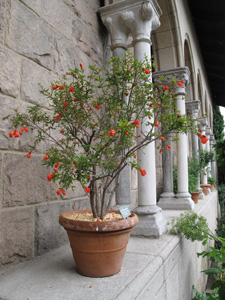
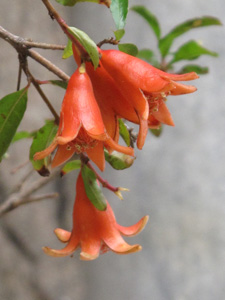
From left to right: The vivid scarlet blossoms of a potted dwarf pomegranate tree in full flower glow against the gray stone of the blind arcade in Bonnefont garden; detail of pomegranate flowers. Both dwarf and standard forms of pomegranate are grown here. Although cultivated for hundreds of years, the dwarf form is not medieval, but it lends itself to pot culture, and can be more easily managed than the full-sized tree. Photographs by Carly Still
Although these photographs were taken just a few days ago on a gray day in Bonnefont garden, this post is coming from sunny California, where I am participating in a panel discussion on museums and gardens at the Getty Center in conjunction with an exhibition curated by Bryan Keene. Read more »
Tags: bay, fig, laurel, olive, pomegranate
Posted in Food and Beverage Plants, Gardening at The Cloisters | Comments (6)
Friday, January 27, 2012

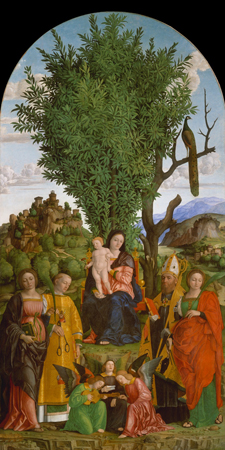
The evergreen bay laurel (Laurus nobilis), a symbol of victory and eternal life, is not as tender as some other Mediterranean species, but it must be grown in pots and wintered over indoors at The Cloisters. Above, left: Bay laurel topiaries like this one spend the winter in the glassed-in arcades of Cuxa cloister and return to Bonnefont herb garden in May. Right: The magnificent bay tree that flourishes at the center of Girolamo dai Libri’s Madonna and Child with Saints represents Resurrection, and is juxtaposed with the naked limbs of a dead tree.
The laurel itself is a bringer of peace, inasmuch as to hold a branch of it out even between enemy armies is a token of cessation of hostilities. With the Romans especially it is used as a harbinger of rejoicing and of victory, accompanying despatches and decorating the spears and javelins of the soldiery and adorning the generals??? rods of office. From this tree a branch is deposited in the lap of Jupiter the All-good and All-great whenever a fresh victory has brought rejoicing, and this is not because the laurel is continually green, nor yet because it is an emblem of peace, as the olive is to be preferred in both respects, but because it flourishes in the greatest beauty on Mount Parnassus, and consequently is thought to be also dear to Apollo, to whose shrine even the kings of Rome at that early date were in the custom of sending gifts and asking for oracles in return.
???Pliny, Historia Naturalis, Book XV, 133
Read more »
Tags: Apollo, bay, cinnamon, Daphne, Dioscorides, evergreen, Girolamo dai Libri, Hildegard of Bingen, Jashemski, laurel, Laurus nobilis, Ovid, Pliny, Pompeii
Posted in Gardening at The Cloisters, Medicinal Plants, Plants in Medieval Art, Useful Plants | Comments (1)
Friday, October 28, 2011
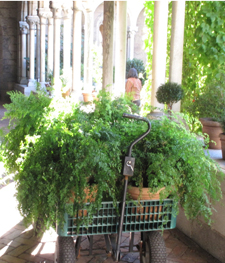
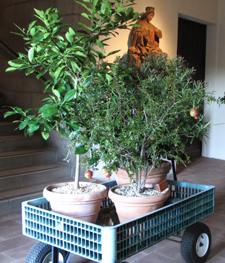
Potted plants too tender to spend the winter in Bonnefont garden are trucked inside and brought up to Cuxa cloister, which is??glazed in mid-October. Mediterranean plants such as bitter orange, myrtle, and bay laurel spend the cold season in the sunny arcades and??are brought back out to the herb garden when the glass comes down in mid-April. Left:??A wagonload of maidenhair fern in the arcade of Bonnefont garden. Right:??oranges and pomegranates en route to Cuxa cloister.?? Photographs by Carly Still
While the medieval plant collection at The Cloisters includes a good number of northern European species, a great many of the plants grown in the Bonnefont Cloister herb garden are Mediterranean in origin. Not all of these southern European plants are hardy for us here in New York City. The garden is a sheltered U.S.D.A. Hardiness Zone 7, and the fig tree (Ficus carica), poet’s jasmine (Jasminum officinale), and lavender (Lavandula angustifolia) do just fine outdoors, but more tender species like bitter orange (Citrus aurantium), rosemary (Rosmarinus officinalis), bay laurel (Laurus nobilis), and dittany of Crete (Origanum dictamnus) must be brought inside and protected from the cold. Read more »
Tags: Albertus Magnus, bay, Citrus aurantium, cucumber, cucurbit, dittany, fern, ficus carica, fig, jasmine, Jasminum officinale, laurel, Laurus nobilis, Lavandula angustifolia, Lavender, maidenhair, myrtle, orange, Origanum dictamnus, rosemary, Rosmarinus officinalis, santolina, winter
Posted in Food and Beverage Plants, Fragrant Plants, Gardening at The Cloisters, Introduction, Magical Plants, Medicinal Plants, Medieval Agriculture, Plants in Medieval Art | Comments (2)
Wednesday, December 10, 2008
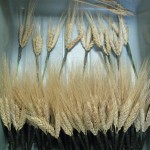


Above, from left to right: ears of wheat wired to florist’s picks; two segments of wheat ears flank a segment of hazelnuts; preparing to hang the wreath in the Romanesque Hall. Photographs by Barbara Bell.
The wreath now on display high on the west wall of the Romanesque Hall above the thirteenth-century limestone doorway from Moutiers-St. Jean was designed and installed for the first time last December. The design is based on that of a wreath motif in a fragment of a fifteenth-century wall hanging in the Museum???s collection, in which four festoons of fruits, leaves, and flowers are bound together with ribbon to form a circle. Read more »
Tags: bay, bread wheat, laurel, Laurus nobilis, Triticum aestivum, Triticum durum, Umbellularia californica
Posted in The Medieval Calendar | Comments (2)









